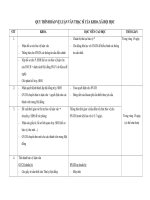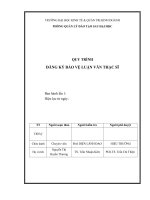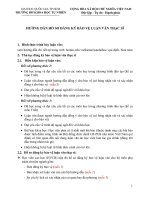Mẫu LaTex Slide bảo vệ luận văn Thạc sĩ Toán Đại học Đà Nẵng
Bạn đang xem bản rút gọn của tài liệu. Xem và tải ngay bản đầy đủ của tài liệu tại đây (60.16 KB, 23 trang )
%\documentclass[handout]{beamer}
\documentclass{beamer}
\usetheme{Madrid}
\usepackage[accumulated]{beamerseminar}
\usepackage{beamertexpower}
\usepackage[utf8]{vietnam}
\usepackage{amsmath,amsxtra,amssymb,latexsym,amscd,amsthm,enumerate}
\usepackage{graphicx,color}
\usepackage{longtable}
\usepackage{eso-pic}
\usepackage{pgf,tikz}
\usetikzlibrary{arrows}
\usepackage{tkz-tab}
%\theoremstyle{definition}
%\newtheorem{dn}[theorem]{Định nghĩa}
%\newtheorem{definition}[theorem]{Định nghĩa}
%\newtheorem{dl}{}[section]
% CHANGED: Moved \title and \author outside of slide
%%\title{BÀI TOÁN DỰ BÁO NỒNG ĐỘ KIM LOẠI NẶNG XUNG QUANH BỜ SÔNG MASS TẠI KHU VỰC
PHÍA TÂY THỊ TRẤN STEIN Ở HÀ LAN}
%%\author[Nguyen Cong Nhut]{Nguyễn Công Nhựt\\}
%----------
\usepackage{xcolor}
\usepackage{tikz}
\usepackage{enumitem}
\usetikzlibrary{calc}
\pgfdeclarelayer{background}
\pgfdeclarelayer{foreground}
\pgfsetlayers{background,main,foreground}
\definecolor{azzul}{RGB}{6,96,167}
%---------\newcommand{\syBrisse}[6][\textwidth-\pgfkeysvalueof{/pgf/inner xsep}-4mm]{%
\begin{center}
\par\bigskip%
\begin{tikzpicture}
\node[rounded corners, text width=#1, align=justify, inner sep=8pt, outer sep=0] (one)
{\medskip\parbox[t]{\textwidth}{\vspace*{3pt}\par#6}};%chinh nho bang
\node[text=black,anchor=north east,align=center, minimum height=20pt, inner xsep=5pt] (two) at
(one.north east) {#5 \hspace*{.5mm}};
\path[fill=#2,draw=#2]
($(one.north west)+(0ex,-4.5pt)$) [rounded corners=3pt] -($(two.north west)+(-22pt,-4.5pt)$) -($(two.south west)+(-4pt,0pt)$) [sharp corners] -(two.south east) [rounded corners] -(one.north east) -(one.north west) [sharp corners] -- cycle;
\node[text=black,anchor=north west,align=center, minimum height=20pt, text height=2ex,inner
sep=8pt, inner ysep=3pt] (three) at ($(one.north west)+(0,-3pt)$) {#4};
\node[text=white,anchor=north east,align=center, minimum height=20pt, inner sep=8pt,inner
ysep=6.5pt] (for) at ($(one.north east)+(0,1.5pt)$) {#5\hspace*{0.8mm}};
\path[draw=#2,line width=0.8pt]
(one.south west) [rounded corners] --
(one.south east) [rounded corners] -(one.north east) -(one.north west) [rounded corners] -- cycle;
\foreach \x in {10,20,...,100}
\path[opacity=\x*0.01]
($(one.north west)+(0.4pt,-6.5pt+\x/100)$) [rounded corners=3pt,draw=gray!\x] -($(two.north west)+(-23.3pt+\x/100,-6.5pt+\x/100)$) [rounded corners=3.5pt,draw=gray!\x] -($(two.south west)+(-5.3pt+\x/100,-1.9pt+\x/100)$) -($(two.south east)+(-0.4pt,-1.9pt+\x/100)$);
\path[draw=white,line width=1.1pt]
($(one.north west)+(0.4pt,-5.2pt)$) [rounded corners=3pt] -($(two.north west)+(-22.3pt,-5.2pt)$) [rounded corners=3.5pt] -($(two.south west)+(-4.3pt,-0.6pt)$) -($(two.south east)+(-0.4pt,-0.6pt)$);
\begin{pgfonlayer}{background}
\path[fill=#3!5]
(one.south west) [rounded corners] -(one.south east) [rounded corners] -(one.north east) -(one.north west) [rounded corners] -- cycle;
\path[opacity=0.5, top color=#3!5,bottom color=#3,middle color=#3!30]
(one.south west) [rounded corners] -(one.south east) [sharp corners] -($(one.south east)+(0ex,0.8cm)$) -($(one.south west)+(0ex,0.8cm)$) [rounded corners] -- cycle;
\end{pgfonlayer}
\end{tikzpicture}
\end{center}
}
%%% DEFFINING AND REDEFINING COMMANDS
%%%------------------------------------------------------%%
% colored hyperlinks
\newcommand{\chref}[2]{
\href{#1}{{\usebeamercolor[bg]{Madrid}#2}}
}
% INFORMATION IN THE TITLE PAGE
%------------------------------------------------------\title[Luận văn Thạc sĩ khoa học] % [] is optional - is placed on the bottom of the sidebar on every slide
{ % is placed on the title page
\textbf{}
}
\subtitle[]
{
\textbf{PHƯƠNG PHÁP HÀM PHẠT CHO BÀI TOÁN CỰC TRỊ CÓ ĐIỀU KIỆN}
}
\author[Đinh Thị H]
{Luận văn thạc sĩ khoa học\\
Chuyên ngành: Toán giải tích\\
Mã số: 60 46 01 02\\
Học viên: Đinh Thị H \\
{Người hướng dẫn khoa học: TS. Phan A}
%{\ttfamily }
}
%\institute[]
%{
%
Trường Đại học Nguyễn Tất Thành\\
%
Khoa Công nghệ Thông tin\\
%
% %there must be an empty line above this line - otherwise some unwanted space is added between
the university and the country (I do not know why;( )
%}
\date{Đà Nẵng, ngày 17 tháng 6 năm 2018}
\begin{document}
%\section{Fit model variogram}
\begin{slide}
\maketitle
\newslide
\center{\bf\blue{Nội dung}}
\tableofcontents
\end{slide}
\section{Một số khái niệm}
\subsection{1.1 Bài toán tối ưu có điều kiện (CP)}
\setbeamercovered{transparent}
\begin{frame}{1.1 Bài toán tối ưu có điều kiện (CP)}{}
%------------------------------------------------------\begin{itemize}
\item<2->
\begin{block}{Bài toán CP}{}
{Bài toán tối ưu có điều kiện (CP)
\begin{equation*}
min \; f(x)
\end{equation*}
với điều kiện $x \in X$, trong đó $f: \mathbb{R}^n \to \mathbb{R}$ là một hàm số cho trước và $X$ là
một tập con của $\mathbb{R}^n$.}
\end{block}
\item<3->
\begin{block}{Cực tiểu địa phương}{}
{Vector $x^* \in X$ được gọi là cực tiểu địa phương của (CP) nếu tồn tại một số $\epsilon > 0$ sao cho
\begin{equation*}
f(x^*) \le f(x), \; \forall x \in S(x^*;\epsilon), \; x \in X.
\end{equation*}}
\end{block}
\end{itemize}
\end{frame}
\subsection{1.2 Bài toán tối ưu có điều kiện cho bởi phương trình}
\setbeamercovered{transparent}
\begin{frame}{1.2 Bài toán tối ưu có điều kiện cho bởi phương trình}{}
%------------------------------------------------------\begin{itemize}
\item<2->
\begin{block}{Bài toán ECP}
{Xét bài toán cực trị có điều kiện cho bởi phương trình (bài toán (ECP)):
\begin{equation*}
\left \{ \begin{array}{ll}
min \; f(x)\\
h(x) = 0.
\end{array} \right.
\end{equation*}
\noindent trong đó $f: \mathbb{R}^n \to \mathbb{R}$ và $h: \mathbb{R}^n \to \mathbb{R}^m$, với
$m \le n$. Các thành phần của $h$ được kí hiệu là $h_1,...,h_m$.}
\end{block}
\item<3->
\begin{block}{Điểm chính quy}{}
{Giả sử $x^*$ là một vector sao cho $h(x^*) = 0$ và $h \in C^1$ trên $S(x^*;\epsilon)$ với một số thực
$\epsilon >0$ nào đó. Khi đó, $x^*$ được gọi là một điểm chính quy nếu các gradient $\nabla
h_1(x^*),...,\nabla h_m(x^*)$ độc lập tuyến tính.}
\end{block}
trong đó $\nabla h_1(x^*) = [\frac{\partial h_1(x^*)}{\partial x^*_1},...,\frac{\partial h_1(x^*)}{\partial
x^*_n}]'$
\end{itemize}
\end{frame}
\subsection{1.3 Bài toán tối ưu có điều kiện cho bởi phương trình và bất phương trình}
\setbeamercovered{transparent}
\begin{frame}{1.3 Bài toán tối ưu có điều kiện cho bởi phương trình và bất phương trình}{}
%------------------------------------------------------\begin{itemize}
\item<2->
\begin{block}{Bài toán quy hoạch phi tuyến (NLP)}{}
{$\left \{ \begin{array}{ll}
min \; f(x)\\
h(x) = 0\\
g(x) \le 0,
\end{array} \right.$}
\end{block}
\item<3-> trong đó các hàm số $f: \mathbb{R}^n \to \mathbb{R}, h: \mathbb{R}^n \to \mathbb{R}^m, g:
\mathbb{R}^n \to \mathbb{R}^r$ là các hàm số đã cho với $m \le n$.
\end{itemize}
\end{frame}
\section{Phương pháp hàm phạt}
\subsection{2.1 Hàm phạt khả vi cho bài toán cực trị có điều kiện cho bởi phương trình}
\setbeamercovered{transparent}
\begin{frame}{2.1 Hàm phạt khả vi cho bài toán cực trị có điều kiện cho bởi phương trình}{}
%------------------------------------------------------\begin{itemize}
\item<2-> \begin{block}{Bài toán ECP}
$
\left \{ \begin{array}{ll}
min \; f(x)\\
h(x) = 0,
\end{array} \right.
$
\end{block}
\item<2-> trong đó ta giả sử $f, h \in C^2$ trong $\mathbb{R}^n$.
\item<3-> Xét hàm Lagrnage:
\begin{equation}\label{eq51}
L(x, \lambda) = f(x) + \lambda'h(x),
\end{equation}
\item<4-> ta có điều kiện cần thiết cho sự tối ưu là
\begin{equation}\label{eq52}
\left \{ \begin{array}{ll}
\nabla_xL(x, \lambda) = 0\\
\nabla_\lambda L(x, \lambda) = h(x) = 0,
\end{array} \right.
\end{equation}
\end{itemize}
\end{frame}
\setbeamercovered{transparent}
\begin{frame}{2.1 Hàm phạt khả vi cho bài toán cực trị có điều kiện cho bởi phương trình}{}
%-------------------------------------------------------
\begin{itemize}
\item<2-> và xét bài toán tối ưu tự do:
\begin{equation}\label{eq53}
min \; \frac{1}{2}|h(x)|^2 + \frac{1}{2}|\nabla_xL(x,\lambda)|^2,
\end{equation}
với điều kiện $\; (x,\lambda) \in \mathbb{R}^n \times \mathbb{R}^m$.
\item<3-> Ta thấy $(x^*,\lambda^*)$ là một cặp điều kiện K-T của (ECP) nếu và chỉ nếu $
(x^*,\lambda^*)$ là một cực tiểu toàn cục của phương trình (\ref{eq53}).
\end{itemize}
\end{frame}
\setbeamercovered{transparent}
\begin{frame}{2.1 Hàm phạt khả vi cho bài toán cực trị có điều kiện cho bởi phương trình}{}
%-------------------------------------------------------
\begin{itemize}
\item<2-> Mệnh đề sau nêu lên mối liện hệ giữa cực tiểu của bài toán tối ưu tự do và bài toán (ECP).
\item<3-> \begin{block}{Mệnh đề 3.1.1}
{Cho $X \times \Lambda$ là một tập con compact của $\mathbb{R}^n \times \mathbb{R}^m$. Giả sử
$\nabla h(x)$ hạng bằng $m$ với mọi $x \in X$. Khi đó, tồn tại một số thực $\bar{\alpha} > 0$ và với mọi
$\alpha \in (0,\bar{\alpha}]$, có một số thực $\bar{c}(\alpha) > 0$ sao cho với mọi $c$ và $\alpha$ thỏa
mãn
$$\alpha \in (0,\bar{\alpha}], \; c \ge \bar{c}(\alpha),$$
mọi điểm tới hạn của $P(\cdot,\cdot;c,\alpha)$ thuộc vào $X \times \Lambda$ là một cặp K-T của (ECP).
Nếu $\nabla^2_{xx}L(x,\lambda)$ là nửa xác định dương với mọi $(x,\lambda) \in X \times \Lambda$, thì
$\bar{\alpha}$ có thể lấy số dương bất kỳ.}
\end{block}
\end{itemize}
\end{frame}
\setbeamercovered{transparent}
\begin{frame}{2.1 Hàm phạt khả vi cho bài toán cực trị có điều kiện cho bởi phương trình}{}
%-------------------------------------------------------
\begin{itemize}
\item<2-> \begin{block}{Ví dụ}
{Xét bài toán trên trường số thực
\begin{equation*}
\left \{ \begin{array}{ll}
f(x) = \frac{1}{6}x^3\\
h(x) = x\\
P(x,\lambda; c,\alpha) = \frac{1}{6}x^3 + \lambda x + \frac{1}{2}cx^2 + \frac{1}{2}\alpha|\frac{1}{2}x^2
+ \lambda|^2.
\end{array} \right.
\end{equation*}}
\end{block}
\item<3-> Trong đó $\{x^* = 0, \lambda^* = 0\}$ là cặp K-T duy nhất. Các điểm tới hạn của hàm số $P$
có được bằng cách giải hệ phương trình:
\begin{equation}\label{eq56}
\nabla_xP = \frac{1}{2}x^2 + \lambda + cx + \alpha x(\frac{1}{2}x^2 + \lambda) = 0,
\end{equation}
\begin{equation}
\label{eq57}
\nabla_xP = x + \alpha(\frac{1}{2}x^2 + \lambda) = 0.
\end{equation}
\end{itemize}
\end{frame}
\setbeamercovered{transparent}
\begin{frame}{2.1 Hàm phạt khả vi cho bài toán cực trị có điều kiện cho bởi phương trình}{}
%-------------------------------------------------------
\begin{itemize}
\item<2-> Từ phương trình \ref{eq57}, ta có
$\lambda = -x/\alpha - \frac{1}{2}x^2,$
\item<3-> và thay vào vào phương trình \ref{eq56}, ta được
$x[x - c + (1/ \alpha)] = 0.$
\item<4-> Các điểm tới hạn của $P$ là $\{x^* = 0,\lambda^* = 0\}$ và $\{x(c,\alpha) = c 1/\alpha,\lambda(c,\alpha) = (1 - c^2\alpha^2)/2\alpha^2\}$.
\item<5 -> Với mọi $c > 0$ và $\alpha > 0$ với $c\alpha \ne 1$, điểm tới hạn $
[x(c,\alpha),\lambda(c,\alpha)]$ không là cặp K-T của (ECP).
\item<6 -> Mặt khác, cố định $\alpha > 0$, ta có $\lim\limits_{c \to \infty}x(c,\alpha) = \infty$ và
$\lim\limits_{c \to \infty}\lambda(c,\alpha) = -\infty$.
\end{itemize}
\end{frame}
%------------------------------------------------------\subsection{2.2 Hàm phạt không khả vi cho bài toán phi tuyến tính (ICP)}
\setbeamercovered{transparent}
\begin{frame}{2.2 Hàm phạt không khả vi cho bài toán phi tuyến tính (ICP)}{}
%-------------------------------------------------------
\begin{itemize}
\item<2->
\begin{block}{Bài toán ICP}
{Xét bài toán (ICP)
\begin{equation*}
\left \{ \begin{array}{ll}
min \; f(x)\\
g(x) \le 0.
\end{array} \right.
\end{equation*}}
\end{block}
\item<3-> Xét bài toán không khả vi (NDP)$_c$, với một số thực $c > 0$ nào đó:
\begin{equation*}
min \; f(x) + cP(x),
\end{equation*}
\noindent với \; $x \in \mathbb{R}^n$.
\item<4-> Trong đó, hàm số $P(x)$ được xác định như sau:
\begin{equation}
\label{eq31}
P(x) = \max\{0,g_1(x),...,g_r(x)\}.
\end{equation}
\end{itemize}
\end{frame}
\setbeamercovered{transparent}
\begin{frame}{2.2 Hàm phạt không khả vi cho bài toán phi tuyến tính (ICP)}{}
%-------------------------------------------------------
\begin{itemize}
\item<2-> Cho $x \in \mathbb{R}^n, d \in \mathbb{R}^n$, ta kí hiệu
\begin{equation}
\label{eq36}
J(x) = \{j|g_j(x) = P(x), \forall j = 0,1,...,r\}.
\end{equation}
\begin{equation}
\label{eq37}
\theta_c(x;d) = \max\{[\nabla f(x) + c\nabla g_j(x)]'| \forall j \in J(x)\}.
\end{equation}
\item<3-> \begin{block}{Định nghĩa: Điểm tới hạn}
$x^* \in \mathbb{R}^n$ được gọi là một \textit{điểm tới hạn} của $f + cP$ nếu mọi $d \in
\mathbb{R}^n$ ta có
$$\theta_c(x^*;d) \ge 0.$$
\end{block}
\end{itemize}
\end{frame}
\setbeamercovered{transparent}
\begin{frame}{2.2 Hàm phạt không khả vi cho bài toán phi tuyến tính (ICP)}{}
%-------------------------------------------------------
\begin{itemize}
\item<2-> \begin{block}{Mệnh đề}
{(a) \hspace{.2cm} Nếu $x^*$ là một điểm tới hạn của $f + cP$, thì lập trình bậc hai (QP)$_c(x^*,H,J)$ có
$\{d = 0, \xi = P(x^*)\}$ là nghiệm tối ưu với mọi $J$ và $H$ với
\begin{equation}
\label{eq319}
0 < H, \; J(x^*) \subset J \subset\{0,1,...,r\}.
\end{equation}}
{(b) \hspace{.2cm} Nếu $\{d = 0, \xi = P(x^*)\}$ là nghiệm tối ưu của lập trình bậc hai $(QP)_c(x^*,H,J)$
trong đó $H$ và $J$ thỏa mãn phương trình (\ref{eq319}), thì $x^*$ là một điểm tới hạn của $f + cP$.}
\end{block}
\end{itemize}
\end{frame}
\setbeamercovered{transparent}
\begin{frame}{2.2 Hàm phạt không khả vi cho bài toán phi tuyến tính (ICP)}{}
%-------------------------------------------------------
\begin{itemize}
\item<2-> \begin{block}{Ví dụ}
{Cho $n = 2, r = 1$, và với mọi $x = (x_1,x_2)$,
$f(x) = (x_1-1)^2 + x^2_2, \; g_1(x) = x^2_1$.
Trong đó, $f$ và $g_1$ là các hàm lồi và (ICP) có nghiệm tối ưu duy nhất là $\{x^*_1 = 0, x^*_2 = 0 \}$.
Xét hàm số:
\begin{align}
\begin{split}
f(x) + cP(x)&=(x_1 - 1)^2 + x^2_2 + c\max\{0,x^2_1 \} \\
&=(x_1 - 1)^2 + x^2_2 +cx^2_1.
\end{split}
\end{align}
Với mọi số thực $c > 0$, hàm số có một điểm tới hạn duy nhất $\{x_1(c),x_2(c) \}$ là
\begin{equation*}
x_1(c) = 1/(1 + c), \; x_2(c) = 0.
\end{equation*}}
\end{block}
\end{itemize}
\end{frame}
%%%%%%%%%%%MD 3.2.8-3.2.11
\setbeamercovered{transparent}
\begin{frame}{2.2 Hàm phạt không khả vi cho bài toán phi tuyến tính (ICP)}{}
%-------------------------------------------------------
\begin{itemize}
\item<2-> \begin{block}{Mệnh đề 3.2.8}
{Cho $X \subset \mathbb{R}^n$ là một tập compact sao cho, với mọi $x \in X$, tập các gradient
\begin{equation*}
\{\nabla g_j(x) | \forall j \in J(x), j \ne 0 \},
\end{equation*}
\noindent là độc lập tuyến tính.}
\end{block}
\item<3-> Khi đó tồn tại số thực $c^* \ge 0$ sao cho với mọi $c > c^*$:
\item<4->
\begin{itemize}
\item[a)] Nếu $x^*$ là một điểm tới hạn của $f + cP$ và $x^*\in X$, thì tồn tại một $\mu^* \in
\mathbb{R}^r$ sao cho $(x^*,\mu^*)$ là một cặp K-T của (ICP).
\item[b)] Nếu $(x^*,\mu^*)$ là một cặp K-T của (ICP) và $x^* \in X$, thì $x^*$ là một điểm tớn hạn của
$f + cP$.
\end{itemize}
\end{itemize}
\end{frame}
\setbeamercovered{transparent}
\begin{frame}{2.2 Hàm phạt không khả vi cho bài toán phi tuyến tính (ICP)}{}
%------------------------------------------------------\begin{itemize}
\item<2-> \begin{block}{Mệnh đề 3.2.10}
{Giả sử $g_1,...,g_r$ là lồi trên $\mathbb{R}^n$ và tồn tại một vector $\bar{x}$ sao cho:
\begin{equation*}
g_j(\bar{x}) < 0, \forall j = 1,...,r.
\end{equation*}}
\end{block}
\item<3-> Khi đó với mỗi tập compact $X$, tồn tại số thực $c^* > 0$ sao cho với mọi $c > c^*$:
\item<4->
\begin{itemize}
\item[(a)] Nếu $x^*$ là một điểm tới hạn của $f + cP$ và $x^* \in X$, thì tồn tại một $\mu^* \in
\mathbb{R}^r$ sao cho $(x^*, \mu^*)$ là một cặp K-T cho (ICP).
\item[(b)] Nếu $(x^*, \mu^*)$ là một cặp K-T cho (ICP) và $x^* \in X$, thì $x^*$ là một điểm tới hạn của
$f + cP$.
\end{itemize}
\end{itemize}
\end{frame}
\setbeamercovered{transparent}
\begin{frame}{2.2 Hàm phạt không khả vi cho bài toán phi tuyến tính (ICP)}{}
%------------------------------------------------------\begin{itemize}
\item<2-> \begin{block}{Mệnh đề 3.2.11}
{Giả sử rằng $f, g_1,...,g_r$ là các hàm lồi trên $\mathbb{R}^n$ và (ICP) có ít nhất một vector nhân tử
Lagrange $\mu^* = (\mu^*_1,...,\mu^*_r)$, theo nghĩa $\mu^*_j \ge 0, \; \forall j = 1,...,r$, và
\begin{equation*}
\inf\limits_{x\in \mathbb{R}^n} \{f(x) + \mu^{*'}g(x) \} = \inf\limits_{g(x) \le 0}f(x).
\end{equation*}}
\end{block}
\item<3-> Khi đó, với mọi $c > \sum_{j=1}^{r}\mu^*_j$, một vector $x^*$ là cực tiểu toàn cục của $f +
cP$ nếu và chỉ nếu $x^*$ là cực tiểu toàn cục của (ICP).
\end{itemize}
\end{frame}
%%%%VI DU 3.2.12
\setbeamercovered{transparent}
\begin{frame}{2.2 Hàm phạt không khả vi cho bài toán phi tuyến tính (ICP)}{}
%------------------------------------------------------\begin{block}{Ví dụ}
{Cho $n = 2, r = 1$, và với mọi $x = (x_1,x_2)$,
$f(x) = (x_1-1)^2 + x^2_2, \; g_1(x) = x^2_1$.
Trong đó, $f$ và $g_1$ là các hàm lồi và (ICP) có nghiệm tối ưu duy nhất là $\{x^*_1 = 0, x^*_2 = 0 \}$.
Xét hàm số:
\begin{align}
\begin{split}
f(x) + cP(x)&=(x_1 - 1)^2 + x^2_2 + c\max\{0,x^2_1 \} \\
&=(x_1 - 1)^2 + x^2_2 +cx^2_1.
\end{split}
\end{align}
Với mọi số thực $c > 0$, hàm số có một điểm tới hạn duy nhất $\{x_1(c),x_2(c) \}$ là
\begin{equation*}
x_1(c) = 1/(1 + c), \; x_2(c) = 0.
\end{equation*}}
\end{block}
\end{frame}
\setbeamercovered{transparent}
\begin{frame}{2.2 Hàm phạt không khả vi cho bài toán phi tuyến tính (ICP)}{}
%------------------------------------------------------\begin{itemize}
\item<2-> Nghiệm tối ưu $\{x^*_1 = 0,x^*_2 = 0 \}$ của (ICP) không là điểm tới hạn của $f + cP$ với một
số thực $c > 0$ dương nào đó.
\item<3-> Ngược lại, không một điểm nào trong số các điểm tới hạn $\{x_1(c), x_2(c) \}, \; c > 0$ là một
nghiệm tối ưu của (ICP).
\item<4-> Do đó, $\{x^*_1 = 0, x^*_2 = 0 \}$ không là điểm chính quy $[\nabla g_1(x^*) = 0]$, và nó có
thể được xác định là không có nhân tử Lagrange tương ứng $\mu^*_1$.
\item<5-> Như vậy Mệnh đề 3.2.8 không thể áp dụng cho một tập compact chứa $\{x^*_1 = 0, x^*_2 = 0
\}$, và giả thuyết của Mệnh đề 3.2.11 bị vi phạm. Bởi vì tại đó không tồn tại $\bar{x}$ sao cho
$g_1(\bar{x}) < 0$, giả thuyết của Mệnh đề 3.2.10 cũng bị vi phạm.
\end{itemize}
\end{frame}
%%VI DU 3.2.13
\setbeamercovered{transparent}
\begin{frame}{2.2 Hàm phạt không khả vi cho bài toán phi tuyến tính (ICP)}{}
%------------------------------------------------------\begin{block}{Ví dụ}
{Cho $n = 1, r = 2$, và với mọi $x$
\begin{equation*}
f(x) = 0, \; g_1(x) = -x, \; g_2(x) = 1 - x^2.
\end{equation*}
Hàm số $P(x)$ có dạng:
\begin{equation*}
P(x) = \max\{0, -x, 1 - x^2 \},
\end{equation*}}
\end{block}
\end{frame}
\setbeamercovered{transparent}
\begin{frame}{2.2 Hàm phạt không khả vi cho bài toán phi tuyến tính (ICP)}{}
%------------------------------------------------------\begin{itemize}
\item<2-> Vì $f(x) \triangleq 0$ là các điểm tới hạn của $f + cP$ không phụ thuộc vào $c$. Chúng là
\begin{equation*}
x = \frac{1}{2}(1 - \sqrt{5}), \; x = 0, \; 1 \le x.
\end{equation*}
\item<3-> Trong số này, chỉ có $x \ge 1$ tương ứng là các cặp K-T của (ICP).
\item<4-> Mệnh đề 3.2.8 áp dụng cho những điểm này với $c^* = 0$.
\item<5-> Các điểm tới hạn $\frac{1}{2}(1 - \sqrt{5})$ và $0$ là không bao hàm Mệnh đề 3.2.8 vì các tập
tương ứng của gradient $\{\nabla g_j(x) | g_j(x) = P(x), \; j = 1,2 \}$ là phụ thuộc tuyến tính. Mệnh đề
3.2.10 và 3.2.11 không áp dụng vì $g_2$ là hàm không lồi.
\end{itemize}
\end{frame}
%%-------------------------------------------------------
\section{Tài liệu tham khảo}
\begin{frame}[t]
\frametitle{Tài liệu tham khảo}
%%{\textcolor{yellow}{Tài liệu tham khảo}}
\textcolor{black}{[1]} David G. Luenberger (1973), \emph{Introduction to Linear and Nonlinear
Programming}, Addison Wesley Publishing Company.
\vspace{0.2cm}
\textcolor{black}{[2]} Dimitri P.~Bertsekas (1996), \textit{Constrained Optimization and Lagrange
multiplier methods}, Athena Scientific, Belmont, Massachusetts.
\vspace{0.2cm}
\textcolor{black}{[3]} Oswaldo González-Gaxiola (2009), ``A note on the Derivation of Fréchet and
Gâteaux'', \textit{Applied Mathematical Science}, Vol. 3, no. 19, 941-947.
\end{frame}
\section*{Lời cảm ơn}
%\begin{frame}[t]{\textcolor{yellow}{\begin{center}
%Lời cảm ơn \end{center}}}
\begin{frame}[t]
\setbeamercovered{transparent}
\frametitle{\hspace{5cm} Lời cảm ơn}
\begin{itemize}
\item<1 -> \large Xin chân thành cảm ơn TS. Phạm Quý Mười, Khoa Toán, trường Đại học Sư phạm Đà
Nẵng, Việt Nam đã giúp tôi trong nghiên cứu.\\
\item<2 -> \large Cảm ơn sự góp ý chân thành của người đọc giúp tôi hoàn thiện hơn trong bản cuối
cùng.
\end{itemize}
\end{frame}
\begin{frame}
\begin{center}
{\Huge Cảm ơn quý Thầy cô đã lắng nghe}
\end{center}
\end{frame}
\end{document}









